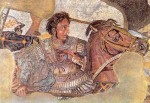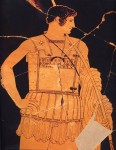 This isn’t breaking news or anything, but it’s news to me and I’ve been obsessing about it for 2 days. Greek armies from at least the 6th century B.C. through the Hellenistic period (the era after Alexander’s conquests when Greek military strength and cultural influence were at their peak) wore an armour made out of linen. It’s called linothorax, a thorax being an armoured chestpiece and lino being, well, linen.
This isn’t breaking news or anything, but it’s news to me and I’ve been obsessing about it for 2 days. Greek armies from at least the 6th century B.C. through the Hellenistic period (the era after Alexander’s conquests when Greek military strength and cultural influence were at their peak) wore an armour made out of linen. It’s called linothorax, a thorax being an armoured chestpiece and lino being, well, linen.
The famous floor mosaic of Alexander found in the House of the Faun in Pompeii depicts him wearing a linothorax. Although the mosaic was made 400 or so years after Alexander died, it is a copy of a Hellenistic original from Alexander’s time. You can’t tell from looking at it what it was made out of, of course, but that kind of armour has been depicted in hundreds of Greek vases, sculptures, reliefs, as well as described in ancient sources.
None of it has survived, however, unlike its metallic brethren, so it’s a bit of a mystery. We know there was tube and yoke armour made out leather as well as metal, but how could linen, a fabric worn in summer because of its easy breezy breathability, provide any kind of protection against arrows and swords?
The trick is layering. Layers of linen were laminated together, glued or stitched in a quilted pattern, creating a remarkably strong barrier against penetration. Of course it wasn’t as strong as metal plate armour, but it had other advantages: light weight, flexibility, comfort, low cost, widely-available, easily crafted materials, and it doesn’t turn into a oven the minute the sun hits it, a major advantage in the scalding Mediterranean summer fighting season. Linen’s unique breathability becomes a laminating advantage, in fact, because once it’s glued together it becomes a solid block.

 University of Wisconsin-Green Bay History professor Gregory S. Aldrete has put the linothorax through a rigorous battery of tests.
University of Wisconsin-Green Bay History professor Gregory S. Aldrete has put the linothorax through a rigorous battery of tests.
This is the mystery that the UWGB Linothorax Project is exploring. Using the available literary and artistic sources, the group has reconstructed several linothoraxes using only the authentic fabrics and glues that would have been available in the ancient Mediterranean. These reconstructions and various sample patches were then subjected to a series of tests to precisely determine how wearable this armor was, and how effective it would have been in protecting its wearer from common battlefield hazards, especially arrows. This involved actually shooting the test patches with arrows and measuring their penetration, as well as hitting them with a variety of weapons including swords, axes, and spears.
The results have so far been impressive. See the UWGB linothorax reconstructions in action:
Linothorax testing (link leads to download of mov file)
Also be sure to check out this sweet poster the UWGB team put together for the 2010 meeting of the Archaeological Institute of America. It won the 2010 Best Poster Award from the AIA, and it’s easy to see why. It covers ancient literary and decorative sources of information about the linothorax, plus the reconstruction process and the test results.

Last but not least, here’s a pattern (pdf) so you make your own ancient Greek armour from the comfort of your own home.
This process of layering sounds similar to what pointe shoe manufacturers do. Pointe shoes don’t actually have wood or anything stiff in the toe box (the part that wraps around your toes), it is just layers of glue and satin. They are extremely sturdy, and I can completely see how a linothorax could withstand arrows and the like. This is a random comment, perhaps, but that’s what this article reminded me of!
It’s not random at all; it’s kind of a genius comment, in fact. I took ballet for 6 years and pointe shoes didn’t even enter my head, but they’re totally analogous. The toe box not only carries the entire weight of the dancer, but it’s designed to absorb a great deal of impact force.
And the linothorax could be mistaken for a tutu on a dark night. 😆
:giggle: It does have a flouncy little skirt.
Fascinating stuff Liv! Good ole linen!
I’ve tweeted this to other History-philes 🙂
H
Thank you! I’m glad you found it as fascinating as I did. 🙂
Congratulations on this fantastic blog!
But if I may intrude with my comment,I noticed above,on the “Linothorax poster” of the University of Wisconsin that Macedonians and Greeks are presented as “separate” peoples which is far from the truth and close to madness… 🙁
Please do not perpetuate wrong and malicious theories that do not hold water and oppose solid archeological writings,findings,facts…
Macedonia was/is part of Greece/Hellas and Macedonians considered themselves as Hellenes of Doric descent…!
Cordial greetings from Thessaloniki,Macedonia,Greece/Hellas
Elias
the linothorax was a brilliant invention. i have even made a accurate model of it and put it to the test.It work good.
This is false :p . Though the Macedonian aristoi may have considered themselves “Hellenistic” that does not mean they were considered so by the Greek world. The Greeks were very snobbish as to who they, the sole arbiters of who was and was not, decided were Greek. Phillip of Macedon had to justify his right to compete in the Olympics by showing he had Greek ancestry. True, whilst Thessaloniki was considered Greek (though rather barbarous) Macedon was a distinct realm with distinct traditions (royalty for instance) and would not have been considered Greek by the Athenians, for example.
Dearest “Anonymous”,the Macedonian aristoi considered themselves not “Hellenistic” but Hellenes…Macedonia was not a distinct realm but a “backward” realm in those times,considering the “civilised” polis of democratic Athens…the snobish Athenians considered “barbarians” every person who did not pronounce Greek correctly,including small villages outside Athens…to make it easier for you to understand,”varvaros” in greek originally meant…lets say “red-neck”,of backward and provincial mentality…Athenians even thought of Thessalians (Aeolians) being “varvaroi”,red-necks, due to their provincial accent of greek,so were the Epeirotans and so on and so on…but I guess I write these in vain for an “anonymous modern barbarian” to understand! :giggle: 😥
For your interest and enlightment be so kind and visit:
http://www.unix.gr/Macedonia/quotes.html …and not only…there are tons and tons of aeons of history that proves your “comment” false… 😉
Your “Linothorax testing” link automatically starts to try to download a file. There is no indication that it is a download and not a normal link. Not cool for those of us on a work or public computer who think they are simply following a link.
Well, the entry is almost four years old. That’s how movie files used to embed but obviously the code doesn’t work anymore. I’ve added a warning so no future wanderers will be afflicted. :thanks:
so your saying that people in Vancouver Island are inherently the same as people in Newfoundland because they share the same country, despite having completely different cultures and identities.
We wouldn’t call them Macedonians if there wasn’t some sort of difference that allowed us to call them Macedonians and not just Greeks.
Spartans are also Greek, yet why are they defined as Spartans and not just Greeks, despite traditional Athenians worshiping the same gods, or atleast acknowledging the same ones.
it’s like saying Protestants are the same as Anglicans because they worship the same god.
they are separate people, just like people in Calgary are separate from people in Edmonton or Red Deer.
we all live on the same planet, yet why have we split up into separate groups and created identities that others do not share
:skull:
Quite nice post on alexander and its armor.Thanks for this information.
The entry is almost many years old. That’s how movie files used to embed but obviously the code doesn’t work. :thanks: